Setting Anchor
River anchors are the focus of this Story by Troy Buzalsky
We all lined up on the riverbank…32 boats deep, looking to better learn how to run our jetboats on some challenging water during the early spring Chinook season. Our boating club hired a subject-matter expert, and we clung onto every word he uttered. As he was discussing reading water, he drew pictures on the sandy beach to help explain a down-river tongue, and up-river V, and then a helicopter flew over us.
It was a Coast Guard helicopter, an unusual sight in this area. A little later, a news helicopter flew over, and a satellite-equipped news truck entered the parking lot. The reporter walked down the boat ramp, dressed for success in her best attempt to look fashionable while wearing a PFD, and started her live broadcast with our group literally photo-bombing her newscast. “I am standing here on the Clackamas River to report a tragedy unfolding,” she echoes with journalistic ease. “The US Coast Guard is confirming that an elderly man has died while attempting to anchor his boat on the Willamette River. Witnesses tell us that he became entangled in the anchor rope and was dragged overboard.” Her voice changed from stoic to emotional as the gravity of the situation hit her.
Our group, unaware of a situation that had unfolded less than 1/4-mile downstream, was dumbfounded. We had 30-plus potential rescuers and boats within a 30-second response. Many, including myself, both rescue swimmers and paramedics. Had we known, we most likely could have made a difference…but we didn’t know.
A Significant Lesson in Safety
That day is galvanized in my mind, because we were all doing what we loved: learning to be better boaters. And even though we all just wanted to up our game while educating ourselves on how to better read and run a river, it reminded all of us of the importance of something taken for granted: the fine art of effective and safe anchoring. A heavy topic!
This Boats column will examine four industry-leading anchor systems from Fish Fighter Products, Mantus Marine, LeeLock Anchor Systems, and Tornado Anchors that will guarantee you safe and efficient anchoring for the waters you fish.
Tornado Anchors
While walking through Royal Treatment Fly Fishing, my local fly shop, I saw a unique item on their shelf: the Tornado Anchor. It had a distinctive look that piqued my interest, and the more I researched the product, the more I understood why it was stirring up so much attention.
On the surface, the Tornado Anchor indeed looks matchless, but its beauty is more than skin deep. In fact, its form follows its function, being not only a great-holding anchor, but also being environmentally friendly. In my world, that’s a win-win!

The Tornado Anchor puts a twist on the age-old anchor design with rotating steel plates that conform to the riverbed. © Tornado Anchor
The Tornado Anchor is a relatively new product launched in 2019, but it’s getting traction from virtually everyone who either uses the anchor or has experienced the anchor in action. It all started when flyfishing enthusiast Keith Webster was using his new StealthCraft Hooligan raft. While cutting his teeth on a west Michigan river, Webster was very unimpressed with the boat’s anchoring ability, or better said, lack of anchoring ability, while using a typical lead-pyramid anchor.
As a design engineer, anchoring occupied his mind on the long drive home. The easy solution was a heavier anchor, but that went against why Webster selected a raft as his fishing platform. As his insightful mind raced, he focused on a typical pyramid anchor only having three- or four sides to grab the riverbed while relying on weight as the securing force. His focus included more surface area, more grab, and less weight. The next day he started to work on a concept that would more efficiently utilize the weight of an anchor while being smarter, safer, and more environmentally friendly.
Innovative Design
The initial design incorporated a series of stacked steel plates that would be offset to create more surface area and grab points. While assembling the prototype on a center eyebolt the plates started to twist before they were welded in place. This dynamic action caught Webster’s attention and a lightbulb came on. From there he manufactured five prototype anchors with rotating stacked steel plates, sharing three with guide friends for research and development purposes. To say the concept was a hit would be a huge understatement, as rave reviews and orders started to flood in from each guide, paving the way for an initial order of 50 rotating stacked plate, ribbed-surface anchors, appropriately named the Tornado Anchor. It created a new spin on anchoring and took the industry by storm.
Conceptually, the Tornado Anchor is engineered so the rotating steel plates conform to the river’s bottom, creating additional surface and edge contact. This increased interaction generates more drag and faster stops without increasing the weight of the anchor. In fact, the Tornado Anchor creates about 20% more holding power than a typical pyramid anchor, and although this might encourage the use of a lighter anchor, Webster suggests “Rather than downsizing your Tornado Anchor, go with the same size and get the added performance.”
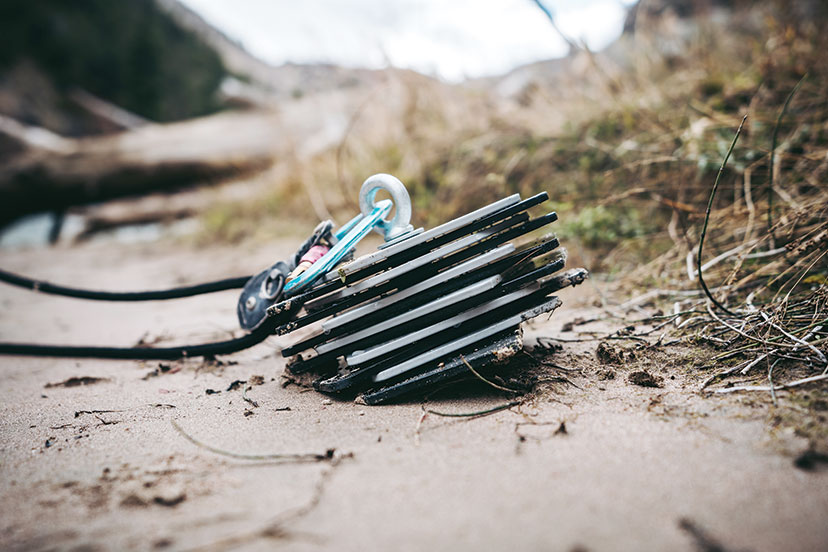
The Tornado Anchor is engineered so the rotating steel plates conform to the river’s bottom, creating additional surface and edge contact. This increased interaction generates more drag and faster stops without increasing the weight of the anchor. In fact, the Tornado Anchor creates about 20% more holding power than a typical pyramid anchor. © Tornado Anchor
The Tornado Anchor is manufactured from a series of galvanized-steel plates that are powder coated in a smart looking, alternating black-and-silver pattern. The patent-pending design incorporates spacers that serve as inner-plate bearings, allowing the steel plates to spin like rotating blades while being spaced to allow sand to travel through the plates whilst keeping rocks from entering into the stacked-plate system. Plus, it’s easily flushed and cleaned, to help reduce transmission of invasive species.
Environmental Impact
Unless you’ve had your head in the sand, environmental impact is a big deal in the marine and fishing industries, yet looking for an environmentally friendly anchor has never been on the radar; that is, until now. The Tornado Anchor is built to be environmentally friendly, made from steel rather than lead. That may not sound like a big deal until you understand that a lead anchor actually sheds, losing material over time. Case in point: An active river guide purchased a 35-pound lead anchor eight years ago, and today, that same anchor weighs just 28 pounds, meaning that 7 pounds of lead has been shed in his local river. Do the math. When you have several hundred river guides all doing the same thing…And remember, 70% of America’s drinking water comes from flowing water.
Product Variety
Tornado Anchors are available in eight sizes from 6- to 45 pounds and are ideal for rafts, drift boats, kayaks, and single-man inflatables like the Water Master. Tornado Anchors also offers a self-draining, laser-engraved anchor nest for clean and efficient anchor storage. To make anchoring even easier, consider the Tornado Anchor SpinRX Pulley that will reduce line twist while providing a two-to-one mechanical advantage. And, speaking of anchor rope, Tornado Anchors offers a lime-green, high-visibility, double-braided, kern-mantle-styled anchor rope designed with the perfect amount of stretch and shock absorption. I can’t think of a reason why a high-visibility anchor rope would be wrong, and when I reflect on the story in my introduction, I wonder if this might have just changed the situation?
Although still a newcomer in the marine industry, Tornado Anchors is holding its own (pun intended). Made in the USA with American steel and hardware, Tornado Anchors has 70 dealers located in 12 states, Canada, and Patagonia, and is also available online at tornadoanchorusa.com. Check out why boat builders, guides, and fishing enthusiasts around the world are appreciating the new spin on anchoring. Stop when you want, where you want, using a Tornado Anchor.
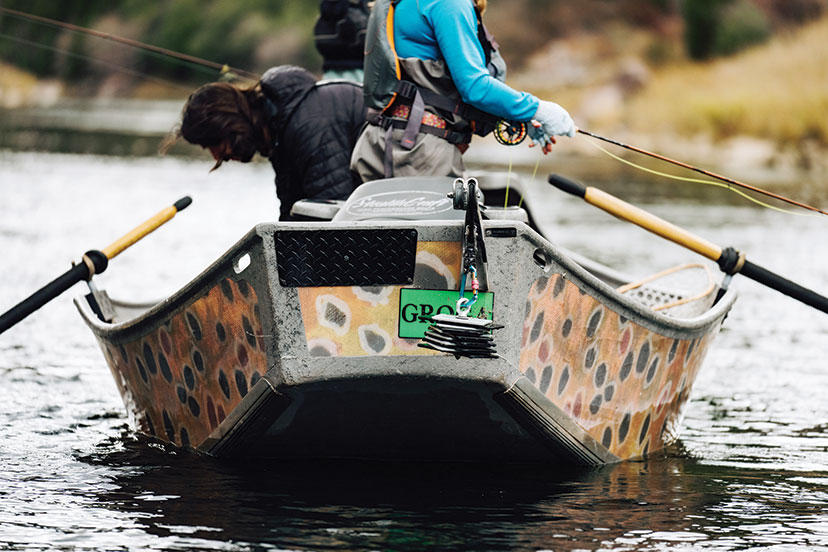
Hanging like a typical lead pyramid anchor, the Tornado is smart looking and performs excellently, while being more environmentally friendly. © Tornado Anchor
Fish Fighter Products
Nikola Tesla famously said, “Invention is the most important product of man’s creative brain. The ultimate purpose is the complete mastery of mind over the material world, the harnessing of human nature to human needs.” At Fish Fighter Products, these words are a driving force behind its entire fishing-friendly product line, and a reason Fish Fighter Products adorn so many boats not just in the Pacific Northwest, but worldwide, including mine.
Fish Fighter Products is led by Mountain Home, Idaho’s Chuck Ceccarelli, who evolved his passion for all things hunting and fishing into an innovative product line of high-performance fishing products. Chuck is no newcomer to the product design-and-manufacturing industry. His career path led him into the tow-and-recovery industry, and he created In The Ditch Towing Products over 20 years ago. Chuck has always been known as an industry innovator, holding several US patents, and ultimately earning a place in the International Towing Museum Hall of Fame.
What started with three employees has grown to over 100, operating on six acres out of their state-of-the-art, 102,000-square-foot facility in Mountain Home, Idaho. The Inventive-Group, the parent company, features four distinct brands; Inventive Products, In The Ditch Towing Products, Razorback Offroad RBO UTV Accessories, and Fish Fighter Products, all with a passion for inventing and manufacturing products that solve everyday problems and make lives easier. With all this industry success, it’s no wonder Chuck Ceccarelli was showcased on CNBC’s Blue Collar Millionaire series.

The Extreme Duty Bow Mount Anchor Nest’s locking bar, which cradles and locks the anchor in place, reduces rattles and increases the overall safety. © Fish Fighter Products
Extreme Duty (XD) Bow Mount Anchor Nest
I remember the first time I saw a Fish Fighter Products anchor nest, I knew the company was doing something special. The Extreme Duty (XD) Bow Mount Anchor Nest had features and capabilities like no other anchor nest in the industry, and today, is still the most safe, efficient, and user-friendly anchor nest available.
The Extreme Duty (XD) Bow Mount Anchor Nest is manufactured from marine-grade aluminum that looks as good as it functions. The exclusive Self Centering V Roller System is precision machined in three pieces of solid, high-density plastic, and features match-machined rope guides to eliminate rope jamming or chaffing.
The item that really sets Fish Fighter apart from its competition is the anchor-locking bar which cradles and locks the anchor in place, reducing rattles and increasing the overall safety. The locking device can also be locked with a padlock to reduce the chance of theft. To further reduce rattles and damage to the anchor nest, guides are manufactured from marine-grade plastic. And because not all boats come equipped with anchoring cleats, the Fish Fighter Products Extreme Duty Anchor Nest comes with an integrated quick-release rope cleat.
Fish Fighter Anchors
Not only does Fish Fighter Products make a great anchor nest, but they also make great anchors to help you anchor your boat in the most challenging of waters. The Fish Fighter Breakaway (Columbia River Edition) River Anchor is a perfect example of anchoring evolution with an engineered design that makes their anchors grab and hold better than their competition.

The Extreme Duty (XD) Bow Mount Anchor Nest is manufactured from marine-grade aluminum that looks as good as it functions. The Fish Fighter Breakaway (Columbia River Edition) River Anchor tines are designed with their proprietary, serrated, patented Grouser Fluke System, specifically aimed for faster self-burying and setting, greater holding power, and with the innate ability to cling to rocks and penetrate hard river bottoms. © Fish Fighter Products
The Fish Fighter Breakaway (Columbia River Edition) River Anchor tines are designed with their proprietary, serrated, patented Grouser Fluke System, specifically aimed for faster self-burying and setting, greater holding power, and with the innate ability to cling to rocks and penetrate hard river bottoms. The anchors are made from steel that is galvanized and come with a breakaway system that is computer designed to pull the anchor free at the optimal angle.
The anchors will nest nicely in Fish Fighter Products’ Extreme Duty XD Bow Mount Anchor Nest as well as LeeLock, Anchor-Caddie, and Miller Marine anchor-locking systems. For increased anchor gripping power, the Fish Fighter Anchor Spade Kit is manufactured from marine-grade stainless steel and features oversized, serrated gravel grousers with a shovel-head design, guaranteed to dig more dirt and grab more bottom. These are easily added onto any Fish Fighter River Anchor.
Kwik-Pull Anchor Retriever
To complete an ideal anchoring system, Fish Fighter Products offers the Kwik-Pull Anchor Retriever, The Floating Anchor Rope Bag, and appropriately sized Anchor Retrieval Buoys. The Kwik-Pull Anchor Retriever was made specifically for a safer anchoring experience. It was designed by the crew at Fish Fighter to be easily installed on your anchor line after you set your anchor out. Their simple rope channel system and one-way locking device allows you to snap the Kwik-Pull onto your anchor line after the anchor is deployed.
In other words, Fish Fighter Products has all your anchoring needs covered, and more. In fact, Fish Fighter Products just launched yet another product that will be a must-have for anglers who own tiller-drive boats, the QRS Tiller Support Handle. It’s like they were reading my mind when developing this product! For more information go to fishfighterproducts.com.
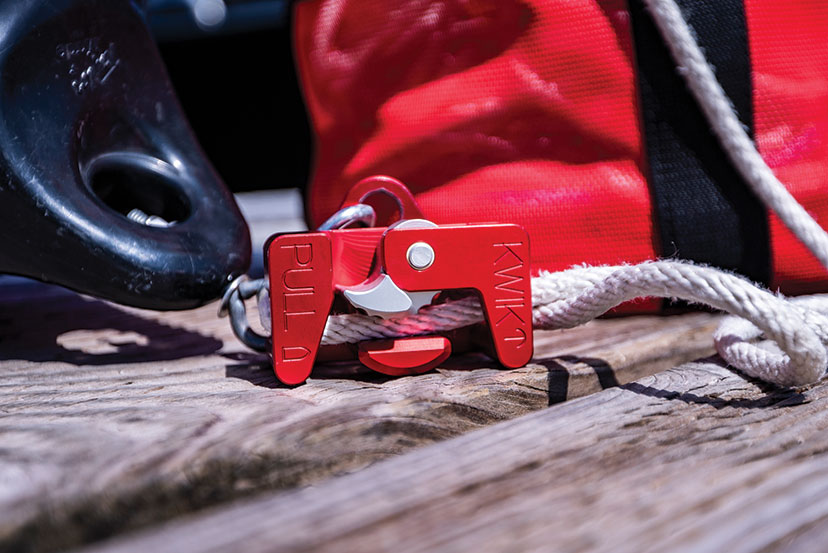
The Kwik-Pull Anchor Retriever was made specifically for a safer anchoring experience. It was designed by the crew at Fish Fighter to be easily installed on your anchor line after you set your anchor out. Their simple rope channel system and one-way locking device are what allows you to snap the Kwik-Pull onto your anchor line after the anchor is deployed. © Fish Fighter Products
Mantus Marine
The marine anchor has been around since the Bronze Age, when mariners used large single rocks, baskets full of stones, and even hollowed-out logs filled with lead to secure their vessels. These anchors worked on the principles of weight and friction. The Romans were the first to actually engineer an anchor with a wooden shank to which the mooring line was attached, with a crown and pointed arms (flukes). This design relied on its shape and style to grab the seafloor, rather than its weight. Interestingly, many anchors still gravitate to this design: shank, crown, and fluke design; but not at Mantus Marine.
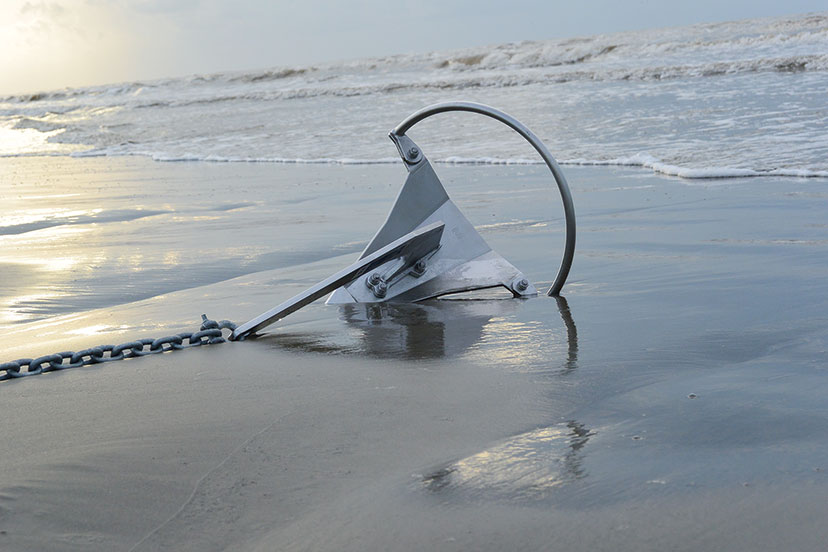
The Mantus M1 Anchor could be described as their flagship anchor and is easily identified with its characteristic rollbar. The M1 is formed from high-quality plate steel with the shank and shank boot welded from top and bottom. The sharp-headed nose is precision machined to achieve the perfect chisel shape to achieve maximum penetrating power. © Mantus Marine
Mantus Marine grew from the frustrations that emergency-room physician Dr. Kutsen had while sailing in Latin America over a 12-month period. Anxiety coupled with close calls while anchoring caused the doctor frustration. Knowing that when lives are on the line, the phrase “Preparation is key” takes on a whole new meaning. Kutsen believed he and his team could design a better-setting and better-holding anchor, thus reducing the frustrations of anchoring while having a more safe and efficient system.
“Dig like no other”
Founded in 2012 in Houston, Texas, Mantus Marine quickly made a name for themselves designing and manufacturing anchors and accessories that “Dig like no other.” They do this by applying science, performance analysis, and engineering principles that actually help shape—literally—the size, style and design of their anchors. The outcome is an anchor that sets and holds in a variety of conditions better than their competition.
Every boat, every angler, and every waterway offers differing conditions, so it’s not surprising to ask the question: What is the best anchor? In many cases we might formulate our answer by looking at similar boats, and make a choice based on what others are doing. Mantus Marine offers some good guidance when selecting an anchor.
Selecting an Anchor
After reading scores of opinions, reviews, and tests done by manufacturers, magazines and government organizations, the subject of selecting the best anchor remains very confusing, not only for the average consumer, but for many experienced boaters and cruisers as well. Mantus Marine firmly believes setting ability is the most important aspect to consider when choosing an anchor. Most often the reason a boat drags (slips) is due simply to the fact that the anchor never set properly in the first place.

The Mantus M2 anchor lacks the M1 rollbar and can be taken apart for easy storage. While a weighted nose is necessary to enable the anchor to roll over without a rollbar, the nose cross-section was optimized not to compromise hard-bottom performance. © Mantus Marine
When Mantus engineered and tested their Mantus Anchor they did so by comparing it to other anchor designs while evaluating five anchoring categories: setting ability in difficult bottoms, holding in loose soil, holding in average conditions, holding in hard soils, and the robustness of construction. The resulting design offered unparalleled setting ability in difficult bottom scenarios, and holding in hard-soil bottoms. And it set them apart from other anchors and manufacturers.
The Mantus M1
The Mantus M1 Anchor could be described as their flagship anchor which is easily identified with its characteristic rollbar. The M1 is formed from high-quality plate steel with the shank and shank boot welded from top and bottom. The sharp-headed nose is precision machined to achieve the perfect chisel shape to achieve maximum penetrating power. The M1 is available from 2.5 pounds to 175 pounds which translates into anchoring options from a dinghy to a 100-foot pleasure craft and everything in between.
The brilliance behind the M1 is its unique rollbar which does exactly what a rollbar should do. It rolls the anchor into its best setting position. Tests have demonstrated the M1 sets faster and deeper than any other anchor tested, and it’s ideal when penetrating most seafloor conditions.
The Mantus M2
The Mantus M2 Anchor was designed to retain the consistent, proven performance of the M1 rollbar anchor and will fit on bows with pulpits and bowsprits. The anchor lacks the M1 rollbar and can be taken apart for easy storage. While a weighted nose is necessary to enable the anchor to roll over without a rollbar, the nose cross-section was optimized not to compromise hard-bottom performance. The shank uses a high-test steel which is designed to withstand side loading on the shank. Robust construction is a cornerstone for both the M1 and M2 Anchors.
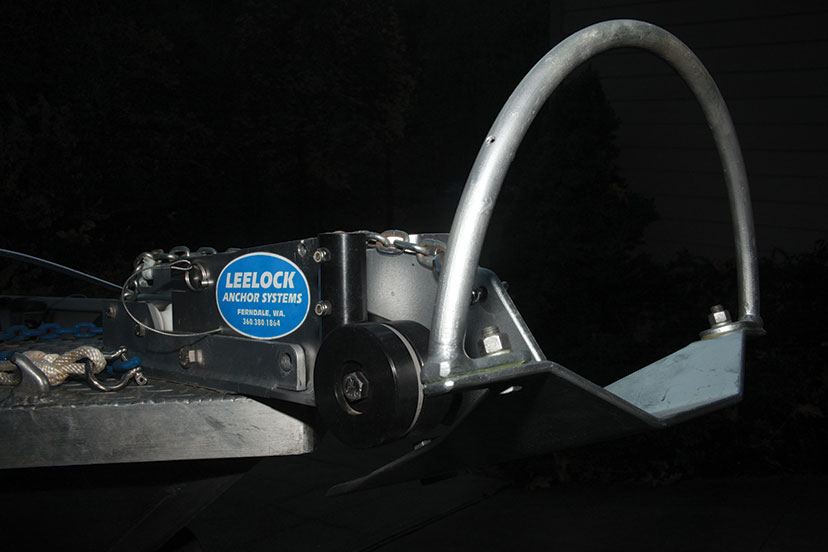
The Mantus M1 Anchor nests nicely in the LeeLock Columbia River Anchor Nest. © Troy Buzalsky
Both the M1 and M2 Anchors are available in hot-dipped, galvanized, high-carbon steel. M1 stainless-steel anchors are manufactured from 316L stainless steel for the fluke and 2205 duplex stainless-steel shanks with its surface hardened by shot peening and then electro-polished to provide maximum corrosion resistance and an absolutely beautiful finish.
For my personal boat I have three anchors that I interchange based on conditions. During spring runoff, I find it difficult to set my rocker anchor or can anchor systems, yet it’s effortless to set my 13-pound Mantus M1. This supports the fact that setting ability is the most important aspect to consider when choosing an anchor. It’s reasons like this that Mantus Marine earned a 2017 Fish Alaska Editors’ Choice Award in the Watercraft and Accessories category. See more at
LeeLock Anchor Systems
It’s been almost a decade since I added the LeeLock Anchor System to my boat and there has been no looking back. Initially, I had a standard Columbia River anchor and nest, which satisfied some of the rivers I fished. But since I was looking to fish and anchor in multiple fisheries and varied scenarios, I made the decision to go with the LeeLock Quick Change system that allows changing from a Columbia River-styled rocker anchor to a can anchor, to a dredge-styled Mantus Anchor, and even someday adding a bow-mounted trolling motor.
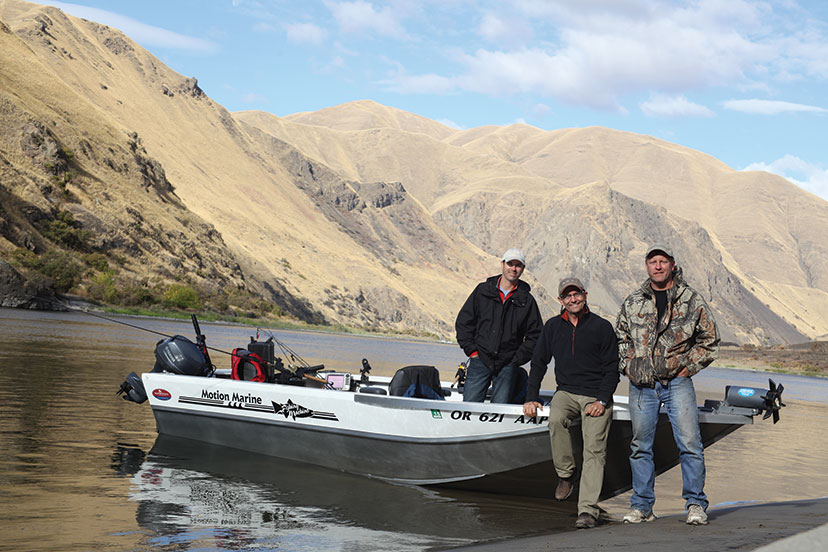
While traveling 30-plus river miles and camping for several days, the LeeLock Anchor Can System worked great, and proved itself in critical situations. © Troy Buzalsky
LeeLock Anchor Systems is a niche company whose name is synonymous with quality, made-in-America anchors and accessories ideally suited for those fishing the Pacific Northwest and Alaska. Leelock Anchor Systems was started in 2008 in Ferndale, Washington, with one patented product: the LeeLock Line Lock, a hassle-free product that simplified anchoring. Today, LeeLock boasts a product line that includes their Driftboat Anchor System, Columbia River Anchor System, Anchor Can System, and their Quick Change Anchor Nest, allowing incredible anchoring diversity.

Sometimes an anchor does more than hold the boat while fishing, and the LeeLock Anchor Can System works great as a beach anchor. © Troy Buzalsky
The LeeLock Anchor Can System
The LeeLock Anchor Can System is a perfect anchor system for a variety of waters. I have found it useful in shallow coastal streams, braided freestone rivers, and meandering silt-bed situations where the weight of the anchor itself provides the holding power. The can anchor is not what you want to use in water over about 20 feet deep because the anchor is very heavy. It is designed primarily for anchoring in small- to medium-sized rivers, or the shallow margins of large rivers.
The “Can” in the name “Anchor Can” is used to describe its size and shape. In fact, when I was a young whippersnapper, my dad made a lake anchor from an old Folgers Coffee Can filled with cement and a wire eyelet to attach the anchor line.
The handmade LeeLock can anchor is designed specifically for smaller jet- or power boats. I’ve used the LeeLock Anchor Can System on a 21-foot North River Commander, my current 18-foot Motion Marine open jet sled, and a 14-foot Mid-Jet, all with great success. The LeeLock can anchor is made from schedule-40 steel pipe with a fully welded steel cone that creates a housing that is filled with ballast lead. LeeLock offers the can anchor in their 40- or 50-pound claw-tine model, or in a 45- or 55-pound shovel-point claw model. The shovel-point anchors are quite aggressive and made for sandy and gravely bottoms.
Simplicity is the beauty behind the LeeLock Can Anchor System, which can be easily deployed and

The crew found the LeeLock Anchor Can System excellent for holding the boat on a gravel bar while exploring nearby sites. © Troy Buzalsky
retrieved by one person, from anywhere in the boat. The system is made specifically for either a 1/2-inch or 5/8-inch anchor rope and utilizes the revolutionary LeeLock Lock Unit that eliminates the need for a jam cleat. The can anchor nest is handmade from anodized aluminum to safeguard from corrosion.
LeeLock Quick Change System
The LeeLock Anchor Can System is part of the LeeLock Quick Change System. This means you can swap out LeeLock products that include the Columbia River Anchor Nest, the Bow Mount Trolling Motor Mount, or the LeeLock Ladder. The Anchor Can head unit includes a clean-looking, anodized slide-and-pivot sheath (the “Can”) that is mounted with a single nut and bolt, and a safety pin.

The interchangeability is the genius behind the LeeLock Quick Change System, here with a Columbia River Anchor nested, and a Can Anchor System on standby. © Troy Buzalsky
To use the LeeLock Anchor Can System just remove the safety pin, and simply pull and lift slightly on the anchor rope. The weight of the anchor slides and pivots downward, dropping the anchor. Once the anchor sets, let out the correct amount of scope, and let go of the rope… The LeeLock Lock Unit will do it from there. To retrieve the anchor simply pull on the anchor rope, and when I say pull, remember, you are pulling a 40- to 55-pound anchor. The anchor will slide inside the anodized can and bed itself while the Lock Unit holds the anchor safe and secure until you’re ready to redeploy the anchor.
Whitewater Tested
Simplicity and versatility are key factors in selecting a LeeLock Anchor Can System, where I find myself using it on at least a third of my boating and fishing opportunities. A few years back I decided to bring the LeeLock Anchor Can System up the Snake River, where we run Class 3 and 4 whitewater while chasing steelhead, sturgeon, and smallmouth bass. Most of the anchoring for us in this

The LeeLock can anchor can be safely and easily deployed from any location in the boat, in this case, under the boat top and out of the weather. © Troy Buzalsky
waterway is on the shoreline or river bank, so the can anchor works great. One morning we were heading downstream from camp for a quick backtrolling session and ran out of gas. Yes, I forgot to add my daily gas allotment that morning. Needless to say, as we quickly floated down a boulder-strewn section of fast water, I deployed the LeeLock can anchor, and to my delight, the anchor grabbed and held until a passing boater offered help. I am not sure my Columbia River anchor would have worked as well in that situation.
Just like there’s no perfect boat, there’s no perfect anchoring system. However, the LeeLock Quick Change Base system offers a plethora of choices and interchangeability, which for me, is priceless. For more information go to: leelock.com
Troy Buzalsky is the Boats columnist for Fish Alaska magazine, and when not writing about boats he can likely be found chasing fish in the Pacific Northwest and the 49th state and writing about those adventures. Troy can be reached at troybuz@comcast.net.
If you enjoyed this river anchor article, read more about all things boating and boating accessories in Fish Alaska’s Boat blog.
The post Setting Anchor appeared first on Fish Alaska Magazine.
